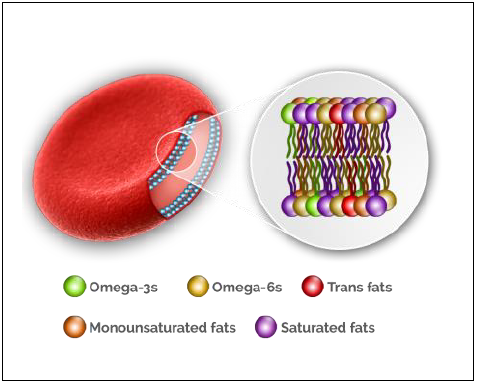Maximizing Wellness: A Deep Dive into the Omega-3 Index and Cellular Inflammation Testing
The Omega-3 Index Complete Test also known as cellullar inflamation testing. It gives you a snapshot of the fats that make up our cells. The test measures the following:
- AA / EPA ratio
- Omega-3s
- Omega-6s
- Saturated fats
- Monounsaturated fats
- Trans fats
- Omega 3/ Omega 6 ratio

Cellular Inflammation: The Silent Disruptor
Often undetectable by pain, cellular inflammation works covertly, disrupting hormonal signals at the cellular level. This can lead to increased fat storage, hastened onset of chronic diseases, and reduced physical performance. Although invisible, its presence is measurable through the Omega-3 Index, specifically by evaluating the AA/EPA ratio in your bloodstream.
Decoding the AA/EPA Ratio
The AA/EPA ratio is a direct indicator of cellular inflammation within your body. While a high ratio doesn’t necessarily indicate disease, it does suggest that your wellness could be optimized. The Omega-3 Index reflects this ratio, and studies, including notable research from Italy, have linked a ratio above 15 to an increased risk of chronic conditions.
AA/EPA Ranges
1.5 to 3
3 to 6
7 to 15
> than 15
Cellular Inflammation
Low
Moderate
Elevated
High
Future state of wellness
Excellent
Good
Moderate
Poor
Dietary Strategies to Optimize Your Omega-3 Index
Pharmaceutical interventions cannot alter the AA/EPA ratio; only dietary changes can. To improve your Omega-3 Index, consider increasing your intake of high-purity omega-3 fatty acids, particularly EPA. This adjustment can swiftly lower the AA/EPA ratio. For long-term maintenance, a diet low in inflammatory foods—like the Zone, Ketogenic, or Paleo diets—can help sustain a healthy Omega-3 Index and reduce cellular inflammation.
EPA and DHA Intake: Tailoring Your Diet for Cellular Health
How much EPA and DHA is necessary to maintain a favorable Omega-3 Index? Research suggests a daily intake of 2.5 grams for individuals at risk for conditions like breast cancer. This dosage aligns with findings from Italian studies, where patients with chronic diseases and high AA/EPA ratios experienced significant improvements with consistent EPA and DHA supplementation. For personalized guidance, regular blood tests can help adjust your EPA and DHA intake to optimize your Omega-3 Index.
Grams of EPA and DHA supplemented per day
0
0.8
2.5
5.0
7.5
AA/EPA Ratio
12.1
4.7
2.6
1.3
1.2
This data indicates that a daily dosage of EPA and DHA of 2.5 grams was sufficient to bring the AA/EPA ratio into the desired range for excellent wellness for these healthy individuals. This level of EPA and DHA recommendation correlates well with an Italian study that demonstrated in patients with various chronic diseases having an elevated AA/EPA ratio (>15) lowered their elevated AA/EPA ratio to approximately 5 with daily supplementation of 2.5 grams of EPA and DHA. This is also indicative that a person with an existing chronic disease may need greater amounts of EPA and DHA to get them into an excellent wellness range compared to a healthy individual. Updated on 6 Aug 2019
However, these are only general guidelines for daily EPA and DHA supplementation. The best indication of the amount of EPA and DHA required to optimize the AA/EPA ratio for an individual is best determined with blood testing every six to twelve months.
Omega 3
The three main omega-3 fatty acids are alpha-linolenic acid (ALA), eicosapentaenoic acid (EPA), and docosahexaenoic acid (DHA). ALA is found mainly in plant oils such as flaxseeds, walnuts, and their oils are among the richest dietary sources of ALA. Canola oil is also an excellent source of ALA. Dietary surveys in the US indicate that average adult intakes for ALA range from 1.8-2.0 g/day for men and from 1.4-1.5 g/day for women.
Eicosapentaenoic acid (EPA) and docosahexaenoic acid (DHA): Oily fish are the major dietary source of EPA and DHA. Dietary surveys in the US indicate that average adult intakes of EPA range from 0.03-0.06 g/day, and average adult intakes of DHA range from 0.05-0.10 g/day.
Humans can synthesize arachidonic acid(AA) from LA and EPA and DHA from ALA through a series of desaturation and elongation reactions. EPA and DPA are also obtained from the retroconversion of DHA. Due to low conversion efficiency, it is advised to obtain EPA and DHA from additional sources.
Omega-3s are important components of the membranes that surround each cell in your body. DHA levels are especially high in retina (eye), brain, and sperm cells. Omega-3s also provide calories to give your body energy and have many functions in your heart, blood vessels, brain, eye, lungs, immune system, and endocrine system (the network of hormone-producing glands). There are multiple benefits to the mind and body in having a higher Omega-3 Index, all of which contribute to slower aging.
Omega 6
Like omega-3 fatty acids, omega-6 fatty acids are polyunsaturated fatty acids.
These fats are primarily used for energy. The most common omega-6 fat is linoleic acid. Linoleic acid itself plays a special role in support of heart health. It reduces total and LDL cholesterol, improves insulin sensitivity and blood pressure.
Gamma-linolenic acid (GLA) is an omega-6 fatty acid found in certain oils, such as evening primrose oil and borage oil. It can reduce a number of symptoms of rheumatoid arthritis.
Conjugated linoleic acid (CLA) is another form of omega-6 fat that has some health benefits. It reduces body fat mass. Updated on 6 Aug 2019
Saturated Fat
A saturated fat is a type of fat in which the fatty acid chains have all or predominantly single bonds. Examples of foods containing a high proportion of saturated fat include animal fat products such as cream, cheese, butter, other whole milk dairy products and fatty meats which also contain dietary cholesterol. The World Health Organization, have advocated for reduction in the intake of saturated fat to promote health and reduce the risk from cardiovascular diseases.
Monounsaturated fat
Monounsaturated fat is a type of dietary fat. It is one of the healthy fats, along with polyunsaturated fat. Monounsaturated fats are found in plant foods, such as nuts, avocados, vegetable oils, olive oil, sesame oils. Foods containing monounsaturated fats reduce low-density lipoprotein (LDL) cholesterol, while possibly increasing high-density lipoprotein (HDL) cholesterol. Monounsaturated fats help develop and maintain your cells.
Trans fats
There are two broad types of trans fats found in foods: naturally-occurring and artificial trans fats. Naturally-occurring trans fats are produced in the gut of some animals and foods made from these animals (e.g., milk and meat products) may contain small quantities of these fats. Artificial trans fats (or trans fatty acids) are created in an industrial process that adds hydrogen to liquid vegetable oils to make them more solid.
The primary dietary source for trans fats in processed food is “partially hydrogenated oils.”
Trans fats can be found in many foods – including fried foods like doughnuts, and baked goods including cakes, pie crusts, biscuits, frozen pizza, cookies, crackers, and stick margarines and other spreads.
Why OmegaQuant Omega 3 Complete Test Kit?
- It is the world’s only laboratory dedicated to fatty acid analysis that is CLIA (Clinical Laboratory Improvement Amendments) certified and regulated by FDA.
- This test has been used in 200+ research studies
- Validated and standardised testing methods by FDA
- OmegaQuant is a recognised expert in fatty acid research


